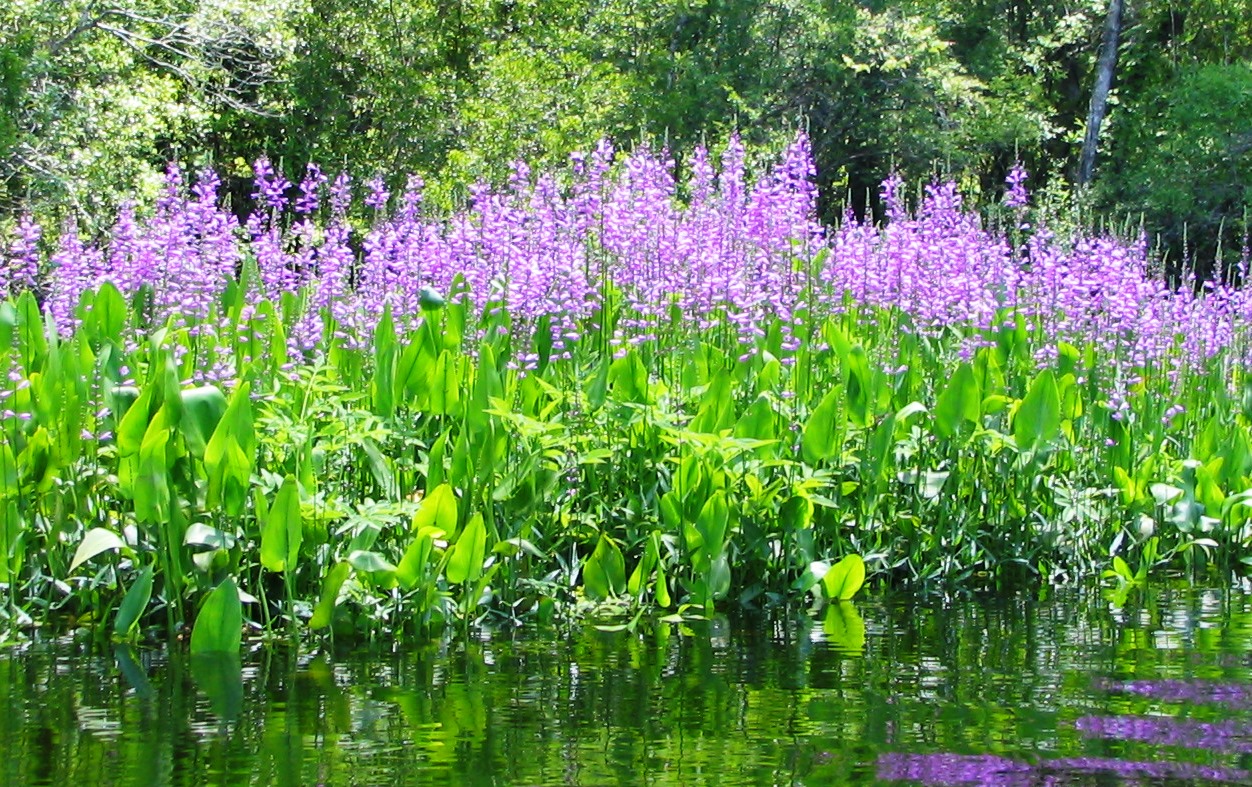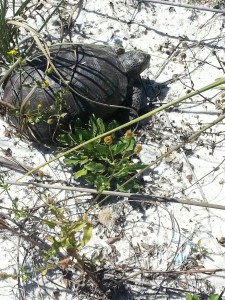
Discover the Beauty and Role of Native Aquatic Plants – in Your Own Pond

A stand of purple flowers called “False Dragon-Heads (Physostegia spp.) growing along the St. Marks River. They are behind a stand of pickerelweed (Pontederia cordata) that has not yet bloomed. Photo: Judy Biss
This is the time of year when gardens burst forth with lush green growth and colorful flowers. With a little planning and management, your backyard pond can also put on the same show each year and fight unwanted pond weeds at the same time!
Fish and farm ponds are abundant in the Florida panhandle. Most are two acres or less and are used for producing catfish, bass, and bream; for recreation and wildlife viewing; for fishing and swimming; and for irrigation and livestock watering. Ponds play an important role in various aspects of agricultural production and rural life, and for that reason, maintaining their ecological health is critical to their many uses.
Managing aquatic plants is one important component of pond ownership. If you are a pond owner, you have probably seen and read many articles related to controlling and removing aquatic weeds. Just as in terrestrial gardens, there are a number of non-native (and sometimes native) plants that can become quite weedy and problematic in and around your pond. Hydrilla, water hyacinth, torpedograss, Chinese tallow, alligator weed, and the tiny water spangles (common Salvinia) are just a few examples that plague our waterways and shorelines. But, controlling and removing weeds is only part of the bigger picture of pond management. Planting native wetland plants is another ecologically important and aesthetically enriching management tool as well.
By establishing beds of healthy native plants, you are also fighting against weedy non-native invasive plants through competition for space. Some other benefits of native aquatic plants are they act as a barrier, filtering fertilizers such as nitrogen and phosphorus from runoff, and they help control erosion. Also, because native plants are adapted to our local environments, they are generally easy to grow, and most require little or no extra water or fertilizer.
Below are a few guidelines to follow if you are considering the use of native aquatic plants in your pond.
Know Your Plants:
Depending on the type, aquatic plants generally grow in three forms. Emerged, like maidencane or bulrush, submerged like coontail and southern naiad, and floating, like the tiny free floating duckweed, and spatterdock and fragrant water lily which are rooted with floating leaves and flowers at the water’s surface. There are many good UF/IFAS publications and online resources for aquatic plant identification. Some are listed at the end of this article.
Plan Ahead:
Some questions to ask are, what is the primary use of your pond? Is it wildlife viewing, swimming, fishing, irrigation, etc.? The answers to these questions will help you determine how much of your pond and shoreline will be planted, and what types of plants to use. For example, if you use your pond for fishing and irrigation, you should leave some areas of the shore unplanted and mowed to allow for access, and you should not plant submerged plants that may clog irrigation intakes. On the other hand, if your pond is primarily for attracting wildlife, you can plant most of the shoreline including some types of submerged aquatic plants.
Right Plant Right Place:
You may have heard this Florida Friendly Landscaping term before, as it holds true for any garden including aquatic gardens. Choose plants that grow best in the water depth and planting “shelves” you have in and around your pond. By “shelf” we are referring to the slope of your shoreline. Is it a gradual, gentle slope into deeper water, or is it steep and abrupt? Also, become familiar with seasonal changes in your pond’s water depth, as it may affect the plants you select.
Prepare For Maintenance:
Just like a vegetable garden, your newly planted aquatic plants (especially those that are emerged) will need attention in the first year or so of establishment. Remove dead plants and weed out unwanted plants.
Where to Purchase the Plants:
For a list of Florida native plant suppliers, visit the Association of Florida Native Nurseries (AFNN) Please Note: collecting wild plants in Florida is subject to various regulations and may require permits! Visit this website for details on wild collection – Florida Plant Collecting and Transport, Regulations and Permitting, University of Florida Herbarium
Here are some helpful resources used for this article with more detail on establishing aquatic plants around your pond.
-
Creating Wildlife Habitat with Native Florida Freshwater Wetland Plants
-
Native Aquatic and Wetland Plant Fact Sheets
-
Aquatic Plant Identification List with Pictures and Videos


